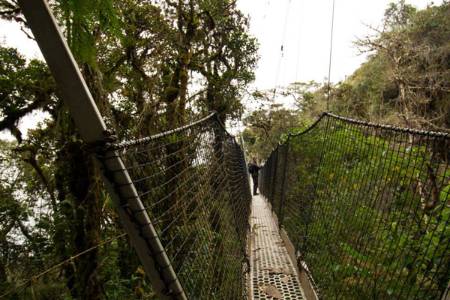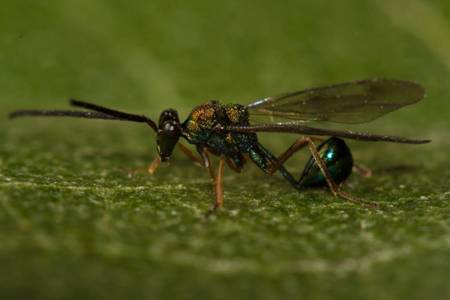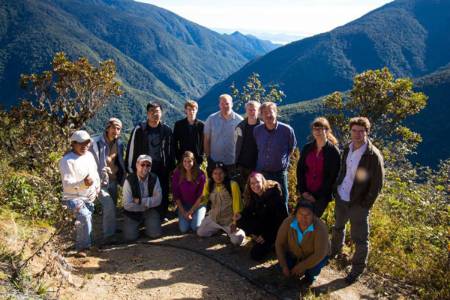Every four years the International Society of Hymenopterists gather for a conference, in a different venue each time. This July, 120 or so wonderful waspy folk gathered in Cusco, in the Peruvian Andes.
Natalie Dale-Skey, Andrew Polaszek and I headed off from the Natural History Museum to the land of the Andean Condor (we didn’t see any) and the gateway to one of the wonders of the world, Machu Picchu (we didn’t visit).
The first important consideration, of course, was how many shirts to pack, given that we were also visiting a field station for a quick post-conference collecting trip at the end. One shirt per day, surely? Invest in a travel iron?
Apparently real travellers (i.e. Natalie) carry three shirts at most, washing them daily in rainwater, and are prepared to make new clothes from abandoned sacking and banana leaves. I am not a real traveller.
What happens at a wasp conference?
Andy presented a new, interactive key for identification of Hymenoptera families that his intern, Miriam Gurpegui, had created. Natalie Dale-Skey presented a poster on the wonders of our chalcid collection. And I gave a presentation on the importance of reliable data when trying to interpret distributions of parasitoid wasps; basically, mistrust all the data and most of the identifications. It’s a bit of a hobby horse of mine at the moment.
I talked about the potential for using museum collections and light traps for quantifying changes in the distribution of British ichneumonid wasps, concentrating on nocturnal Ophion and Netelia species, with an example shown in the maps below. But most of the specimens have been misidentified in the past, and almost none of the literature can be trusted, so it is hard work interpreting whether or not big apparent changes in range are real. I also pointed out some examples of spurious results in published studies that are based on rubbish published data. As scientists we need to be aware of bias in our data.
 The first distribution maps for a British Ophion (an ichneumon wasp); pre-and post-2004. Real range expansion or just better recording?
The first distribution maps for a British Ophion (an ichneumon wasp); pre-and post-2004. Real range expansion or just better recording?
In the session that I chaired, I forgot only one speaker, so it was really quite a success. And we were able to fit him in at the end of the day anyway.
So what’s going on in the world of wasps? Big data are big. We saw a phylogeny - the evolutionary development and history of a group of organisms - constructed from 30,000 genes. There are new approaches to phylogenomics that should allow us to sequence thousands of genes even from relatively old, pinned specimens.
But taxonomy, ecology and morphological phylogenetics are all still active fields. Some of my highlights were a presentation on the manipulation of spider behaviour by ichneumonid parasitoids and some innovative methods of examining fossil Hymenoptera – yes, fossilised wasps, bees, ants and sawflies. The student presentations were of uniformly great quality, which put the rest of us to shame.
Conference chums
New collaborations were forged, often over coffee and cakes (we all put on weight), and of course over beer in the evenings. The altitude (Cusco is at 3,500m) discouraged some of the wilder over-indulgence (at least at first) but we couldn’t resist cocktails in the wildly inappropriate ‘Era Caos’, a ‘disco lounge bar’, apparently the disco cousin of A Clockwork Orange’s Korova Milk Bar.
Esteemed hymenopterists in their natural setting - Cusco's finest DiscoLoungeBar, shortly before being moved to another, even stranger room, to make way for people in suits, with more money.
For me, one of the highlights was meeting people I’d corresponded with and assisted. There was a large Brazilian contingent, testament to the funding for taxonomy in Brazil and the enthusiasm for working on their incredibly rich fauna.
Natural History Museum highlights
Other highlights for the Museum were John Noyes receiving (in his absence) the society’s distinguished research award for his decades of work on the Universal Chalcid Database and prolific taxonomic output, and Andy was voted president-elect of the society, taking over in two years’ time.
Bull’s testicles proved not to be a culinary highlight.
Curator of Hymenoptera in Stockholm, Hege Vårdal, and Gavin are the envy of the other hymenopterists, with their big plate of bull's balls. The perspective is correct: the glasses of Chicha were unfeasibly large (photo courtesy of Kazuhiko Konishi).
Guinea pig also proved unpopular but Alpaca was a hit. Pisco sours were even more popular. I think everybody was sick of pan pipes after about ten minutes.
Hymenopterists getting sunburnt.
An excursion day allowed some of us to add a few nice birds to our lists. Giant Hummingbird was, indeed, big. For a hummingbird.
Time for a wasp hunt
Of the several post-conference collecting options, we headed off to the Wayqecha research station, in the cloud forest of the Kosñipata Valley. Mainly because ‘cloud forest’ sounded rather cool. It was indeed cool, in both senses of the word. Nights were very chilly and collecting was fitful as clouds and rain drifted in and out of the valley.
Clouds rolling in, Kosñipata Valley.
We were treated to Hooded Mountain-tanagers eating fruit above our heads and Amethyst-throated Sunangels (hummingbirds again) zipping around. When the sun did shine the wasps were flying and we managed a fairly good haul. At least for Natalie and I, this was our first experience of live Eucharitidae. These are strange chalcid parasitoids of ant larvae. Elegant but bumbling, an undescribed Orasema species is common at Wayqecha.
Lovely, bumbling male of an undescribed Orasema sp. (Hymenoptera: Eucharitidae) (photo courtesy of Miles Zhang).
John Heraty and his students had managed to find its host on the first night there, partly through the ingenious deployment of cookie crumbs, but mainly through luckily uprooting some vegetation, revealing an ant nest with eucharitid pupae.
Most excitingly, there is a canopy walkway, a rather wobbly affair taking you through the tree-tops at the level of the bromeliads and orchids. Leaning over the edge and tapping the vegetation over a net caught me about five Hymenoptera but obviously had to be done for the heroics.
Thrilling canopy walkway at Wayqecha.
 Collecting (ineffectively) from the walkway (photo courtesy of Miles Zhang).
Collecting (ineffectively) from the walkway (photo courtesy of Miles Zhang).
What do we gain from a conference like this? Specimens, obviously, although not all that many, from three days’ collecting. Much more importantly, we get to network, get involved in grant applications, spread the word about the work we do at the Natural History Museum, hear what exciting work is being carried out elsewhere, make friends, taste strange foods and feel like an appreciated part of a vibrant community of researchers, in a refreshing break from work. Now to put the renewed enthusiasm in to practice, back in London. After coffee. Or tomorrow.
Light-trapping at Wayqecha.
And saying goodbye (reluctantly) to Wayqecha (photo courtesy of Miles Zhang).




